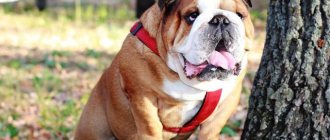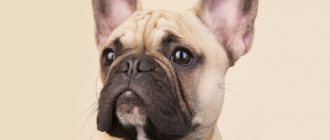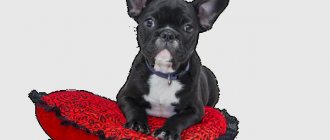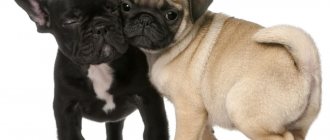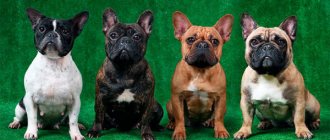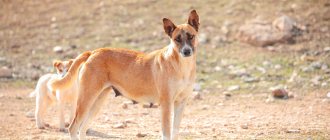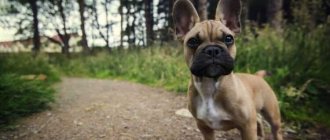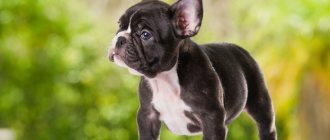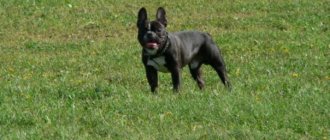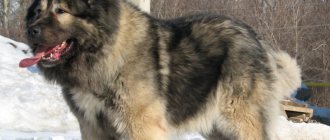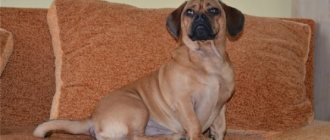French bulldogs, thanks to their original appearance and unique character, have won the hearts of millions of “dog lovers” around the world. At the beginning of the 20th century, representatives of this breed were at the peak of their popularity. Their cost reached up to $5,000. Representatives of the breed are multifaceted: they are excellent watchmen, rat catchers, and companions for lonely people.
At the same time, the bulldog’s mischievous disposition does not allow him to sit still for a long time, so in large families he will gladly participate in all the entertainment and will definitely make friends with children. Let's figure out what owners of dogs of this breed need to know.
French bulldog care and maintenance
The French Bulldog is a smooth-haired dog and therefore does not require much grooming. The breed has gained great popularity all over the world also due to its unpretentious maintenance.
The French Bulldog is a very clean dog. It seems like it was specially created for keeping in a city apartment. If long-haired dogs leave an odor in the apartment, shed, and after walks in dirty weather they cause the owner a lot of trouble, then the French bulldog is an odorless dog and after walks you only need to wipe its paws and belly with a dry cloth. The French Bulldog sheds moderately, like all smooth-haired dogs. Its fur does not fly around the room, which is very important if someone in the family suffers from allergies
French bulldogs have a short, wrinkled muzzle; in some dogs, the wrinkles are too deep, so the delicate skin in the folds can swell and cause anxiety to the dog. It is necessary for such dogs to lubricate the folds on the face with zinc or non-phthalan ointment every day.
It is advisable to inspect the dog’s coat, eyes, ears, and paws daily. Ears should be kept clean by removing dirt with a cotton swab. French bulldogs have a characteristic feature - a short, kinked tail. It is necessary to ensure that these places are clean and wash them periodically to avoid inflammation of the anal glands. You can wash your dog with soap no more than once a year. It is imperative to ensure that your dog’s nails do not grow excessively. French Bulldogs' paws should be in a ball, not loose. Therefore, it is necessary to trim the overgrown horny part of the claw. Adult dogs trim their claws in the summer when walking on asphalt and hard ground.
Keep an eye on your dog's teeth. If you notice a gray-yellow plaque on your teeth, contact your veterinarian to remove tartar, as they lead to tooth loss.
An experienced owner always quickly notices any deviations in behavior. If the dog is very itchy, restless, has become worse at eating its usual food, and is lethargic, then it is necessary to conduct a more careful examination, and if the reasons are not clear, then you should immediately seek qualified veterinary help.
An adult dog should be walked at least twice a day. When walking, French bulldogs are active and emotional; they can be cocky and pugnacious by nature if these habits are not stopped during puppyhood. Not knowing fear, some bulldogs (especially males) can tackle a large dog, which in turn can lead to a fight involving stronger and more vicious dogs.
The French Bulldog is not adapted to long running, especially in the heat.
Some owners put various vests on their dogs, but it is better to reduce the time of walking than to make a sissy out of a bulldog. Some French Bulldogs, like other short-faced dogs, may snore while sleeping.
Don't pet your puppy's ears. This is a very gentle place. The ears can be damaged and they will not stand up correctly or have a camber, which is a defect. Ears usually stand up by three months. It happens that very large ears stand up completely by five months. In order for the ears to stand up faster, you need to give cartilage, more raw meat, and mineral supplements.
Group HELP GROUP FOR ENGLISH BULLDOGS VKontakte
HELP GROUP FOR ENGLISH BULLDOGS 06/29/2021 19:59:43
very good, relevant, IMPORTANT post, borrowed from FBuk. Be sure to share this post with your dog owner friends and take note of the information. I sincerely thank the author of this post. Hogweed is a special disaster in the Leningrad region: in the southern direction, all fields that have been unplowed for 20 years are completely polluted with hogweed. Hogweed has come close to residential settlements and such a misfortune awaits not only foolish children, but also your naive city dogs, who have not yet learned the hard way what this wonderful grass is and HOW the search for thick shade on a hot day can end for a dog’s skin.. ……… ………….. Yulia Matroskina - https://www.facebook.com/profile.php?id=100003389331801 A LOT OF LETTERS ABOUT HORGE or don’t repeat our mistakes. Instead of a preface, I express the hope that all carriers of white Polt with their precious opinion “how could you let a dog into the hogweed” (from the creators of “a good mother’s child does not get sick with anything” ETM) remained on Instagram. I’ll start with the main thing, and then move on to the details for those who are interested in them. This information is based on my personal experience, I will be very glad if it is not useful to anyone. But if it is useful for good, that’s also good. However, remember: in any case, the best recommendation is still a visit to the veterinarian as soon as possible after all urgent actions have been completed. So, perhaps these are obvious things for some, but as it turns out, there are variations. 1. Hogweed growing on its own is not as dangerous as mowing it, especially FRESH, especially if the mowing was done not at the root, but with a small butt. Among a large amount of grass, it may be barely noticeable or not noticeable at all. There is fresh juice, contact with which is many times more dangerous than with a living plant. This is personal experience, but there is also information (I haven’t checked) that even dry mowing of hogweed remains dangerous. 2. If a dog, EVEN WALKING NEXT TO YOU ON A LEAS, and in your opinion, has not been in contact with anything dangerous, has a dark spot on its face (mainly on its nose), reminiscent of wet splashes, especially if the weather is not humid and there is no moisture at all. nowhere to take it - URGENT: 3. on the beak - a handkerchief, a Panama hat, a T-shirt, in extreme cases - cover it with your hand, hold the dog in your arms, or by the collar, and run into the nearest shadow, ideally - into the house. Hogweed juice gives a PHOTO burn, i.e. Requires ultraviolet light to activate. In the shadows he is not dangerous. 4. Rinse the wet area with plenty of water or chlorhexidine in water. Give suprastin or an available analogue in a dosage according to weight. 5. If you have it on hand (and, as a rule, it is in a regular first aid kit), apply DEXPANTHENOL ointment, but if you are in the initial stages, baby diaper cream WITH ZINC would be ideal. NOT WORTH: using levomekol, widely recommended on the Internet, and powder powders such as baneocin. Apply the ointment after a compress with chlorhexidine, when the compress area dries out. 6. See a good veterinarian in the next few hours and follow his recommendations. We were recommended the wonderful cream ARGOSULPHAN, which we also used to treat our burns. Yes, we also received burns, approximately at the level of the ankle and a little higher. No, we didn’t deliberately trample through the hogweed thickets. 7. Even if you are 100% sure that you have an incredibly well-mannered dog who, on command, will not scratch his nose with his paw, put a collar on her/him. Because as soon as it starts to burn (and it still starts to burn), he/she will want to scratch. And it will be blood, tin, decay and darkness, dear friends. 8. The dog will suffer for about 2-3 days. Prepare to suffer with him. In the next 3-5 days, all the partying will be either in the early morning, when there is no sun, or in the late evening, when the sun sets. There is a particularly good option when it’s cloudy, but we were lucky like that a couple of times. Now the details. So, as in the fossilized “911 service,” it was a sunny day, the middle of the week, and nothing, as they say, was predictable. As always, I tried to do five things at once (tied cucumbers, entertained my daughter, looked after the stove, helped straighten the pool and coordinated the collection of applications in the village for meat delivery in a WhatsApp chat). My husband was filling the pool with a hose. Weiss actively helped, galloping around, occasionally receiving a portion of water in his mouth, and was completely delighted with the process - tumbling across the lawn (!!), as usual. At times, his delight went beyond the 7-plus acres of lawn allotted to him for walking, and he began to gallop (really gallop, his hair back) around the perimeter, sometimes running outside the boundaries of our site. Yes, the two neighboring plots are not fenced; construction has not yet begun there. But we already know our neighbors well and they don’t mind that Weiss still considers their plots to be his hunting grounds. And this whole country pastoral lasted about three hours, until lunch, when everyone was driven into the priesthood. Weiss, my husband, and I were also wet from head to toe, since the weather required bathing and dousing. And then, throwing a towel over one white woolen butt, I discovered that there was a dark wet spot on my nose, which for some reason did not go away after wiping it off. I went to look in detail, and became very tense: in the very middle there was a swelling, and around it, as if under the skin, there were small tubercles. Still not understanding anything at all, but immediately imagining a bite, she rushed for chlorhexidine, moistened a gauze pad, and pressed it to her nose with one hand. Another was feverishly Googling symptoms. Almost in the second minute I came across an absolutely similar appearance on the face of a bull terrier. Hogweed. But stsk, WHERE?!? So, the curtains in the house were immediately drawn, dexpanthenol was swelled on Weiss’s nose in commercial quantities, a suprastin tablet was given inside, and my husband and I (who was about to leave for the evening shift) went to look for where the hogweed could have appeared on our bald-shaven lawn. And we found it. Empirically, by sticking your feet in. On the neighboring (!) site. Which was mowed down yesterday (!). There was no way to take Weiss to the clinic: we have only one car, and Sasha drives it to work. He left, and I stayed to study the materiel. Weiss, meanwhile, had already begun to show an unhealthy interest in his injured beak. He rubbed it against the sofa, pillows, etc., and hinted in every possible way that it would be nice to go for another walk. Even then, the idea of a collar began to appear, but was dismissed with indignation. Why can’t I take care of the dog in the house? (Ha ha ha, 3 times). On the Internet they recommended Levomekol. We had Levomekol and was immediately removed from the refrigerator. After the levomekol (!), Weiss began to try to scratch his nose even more intensely (logical, but my brain was already fermented with panic). As a result, the dog scratched his nose until it bled, out of despair, I filled him with baneocin and spent the whole evening rushing from child to dog, and thinking about whether to put them in a crib together. We went for a walk after sunset, and it took incredible effort for me to stop Weiss from trying to roll on the grass with his nose (I couldn’t stop him a couple of times, and all the dancing with the compress was repeated). In the morning we went to the veterinarian, where they gave us a full schedule and strongly recommended a collar. The nose was already covered with blisters almost entirely, the central one was incredibly wet, the rest were preparing to do the same. Well, we bought a collar, the necessary ointment (poor Weiss!) and went home, observing the regime. The regimen consisted of 4-5 times (per day) a compress on the nose in order to disinfect and remove the remains of baneocin and dirt that accumulated during walking/scratching. When my nose dried out, I alternated argosulfan with that same zinc cream and dexpanthenol. The results are visible in the photo, and I can say that the progress makes me happy. Already last night the collar was removed, and my nose could no longer be combed. But I still went for a walk, having in my arsenal 2 liters of water, a bottle of chlorhexidine, a bunch of gauze pads and dexpanthenol. And yes, now I also don’t go for a walk without 2 liters of water. I throw it in the trunk of the stroller. We drink at the same time. Over the past week, I have become the largest village hogweed specialist, because literally three days after Weiss (!!) another dog fell into the mowing. Lab is a purely leash-based walk, so “why don’t you let the dog go without a leash,” unfortunately, doesn’t work. The owner is still in shock and doesn’t understand where the hogweed could have come from on her dog’s path. Welcome to the club, as they say in our village. Yes, our legs also healed relatively quickly under argosulfan, although in this bustle I periodically forgot to apply the burn to myself, and didn’t even feel pain. I remembered in the evening when I felt like a dozen gadflies were eating my ankle at once, slurping and choking. She correlated the sensations with a delicate white nose, internally shed tears and ran to regret it just once more (although much more, and so she almost never left Ushan’s side). During these days, Ushan became a truly exemplary child, steadfastly enduring compresses and smears (obviously, they gave great relief) and gladly accepted affection and unscheduled offerings. Man is weak and sinful, yes, and you don’t have to tell me that in this way I will spoil the dog. Actually, that's all I had to say. Not for hype, but for benefit. Be careful, take care of yourself and your blondes. And also brunettes, redheads and other speckled ones.
22 0 9
Aggression of protest
The behavior of a dog in a pack is subject to certain rules. If these rules are violated by other members of the pack, and this violation infringes on the rights of the dog, it protests. Simply put, the dog protects its bone, bowl, toy, resting place from encroachment. If a dog meekly gives a bowl or toy to you, this does not mean that he will give it to your child just as meekly. Moreover, children (like puppies in a pack) have a lower position in the table of ranks than adult members of the community.
Protest occurs not only when protecting resources. By protesting, the dog makes it clear that your behavior towards it is unpleasant to it, and it does not intend to tolerate it. We are not talking only about actions that certainly cause pain or inconvenience to the dog. Under some circumstances, caresses can also be annoying - after all, people also believe that sometimes caresses are inappropriate. Dogs can (again, like people) express their dissatisfaction in different ways. Some endure it with a sour look, others begin to protest: grumbling and snapping. Unfortunately, the dog has little choice. In nature, an adult wolf can simply move away from annoying wolf cubs. But a dog tied to a chain or confined within the four walls of an apartment has no way to evade uninvited violators of its individual distance.
By the way, about the distance. Wolves and dogs, especially large working breeds, need to maintain the so-called individual distance. What does it mean? Unlike primates, many of whom in childhood are literally stuck to their relatives and in adulthood often sit hugging and clinging to each other, dogs maintain physical contact to a different extent. Little puppies sleep side by side. Adult dogs often sleep and rest at a certain distance from each other, without laying their heads on their companions or even touching. Unlike monkeys, the caresses of dogs are fleeting, gentle, without squeezing or hugging. Dogs also don't spend hours digging through each other's fur like our four-armed ancestors.
Dogs do not like intrusive, rough caresses with squeezing and patting. Especially if they are addressed to the dog at the wrong moment - when it is gnawing on a bone, sleeping, or resting. She does not perceive these caresses as caresses, but as violations of individual distance. If the individual distance is violated occasionally, a calm, socialized dog tolerates this relatively without stress. But if the distance is violated often, rudely and for a long time, discomfort increases, stress and irritation grows, and the dog begins to grumble and snap at the child. Growling has several functions, the main one being warning. You cannot punish a dog for warning of its intentions. If her protest is justified, punishment will only increase the dog's stress. Yes, maybe you will be able to suppress manifestations of discontent for a while. BUT irritation driven inside and finding no way out will one day burst out like a ripe abscess, and then a tragedy can occur...
History of the French Bulldog in the USA
In the United States, dogs imported from France have aroused great interest among amateur and professional dog breeders. American breeders began serious breeding of the French bulldog breed in the early eighties of the nineteenth century.
For American breeders, unconstrained by French breed standards, there was simply a limitless field of activity, so they managed to get dogs with very high conformation indicators. In addition to the colors that have already become traditional for this breed, American breeders contributed to the spread of dogs with fawn, red and even cream-colored coats.
Later, overseas, it was quite easy to create the very first club in the world that specialized in French bulldogs, and already in 1889, a popular New York hotel called the Waldorf Astoria opened its doors to host the very first single-breed exhibition show of French bulldogs. Thanks to the great resonance of this exhibition, the number of American admirers of this breed has increased very sharply and quickly.
However, it must be remembered that the breed standards of American dogs have several quite noticeable differences from dogs of European origin. As practice shows, French bulldogs bred by American breeders are somewhat smaller in size. The average weight of such an adult French bulldog does not exceed 11-12 kg. Among other things, American individuals of this breed are characterized by a wide variety of colors.
Breed standards in America allow the French Bulldog to have cream, fawn and spotted colors with fawn spots. Fawn and spotted fawn dogs were recognized by the FCI standards just over twenty years ago, and French bulldogs with cream coats are still classified as non-standard.
Best Thoroughbred how to spell it?
Ear diseases
This part of the body in bulldogs is practically not susceptible to disease. But still, sometimes all sorts of troubles still happen with the ears of these dogs. The most common ear disease in French bulldogs is otitis media. When this problem occurs, the dog often tilts its head to the side and begins to shake it. Also symptoms of otitis media are:
- thickening and peeling of the skin of the outer ear;
- squelching and pain in the sink when pressed.
Otitis media in French bulldogs is treated depending on the form of this disease, which can only be determined by a veterinarian. But in any case, if a dog has such a problem, its ears are usually treated with Miramistin.
Dried crusts of wax in a bulldog's ears are cleaned with a damp cotton swab. After this, the inside of the dog’s shells is wiped with peroxide. To alleviate the dog’s condition, “Otinum” or, for example, “Sofradex” is instilled into his ears.
Newborn puppies
They stay in the womb for almost 2 months. They are born with closed eyes, a pink nose, eyelids and a short tail. The ears are not erect yet; they rise much later.
At this age, all their actions are aimed at eating, sleeping and heating. Newborn French Bulldogs instinctively seek out a warm place. Milk is sucked several times a day, and the bitch cleans and cares for them while she feeds.
Weight is gaining rapidly. By 10 days of age, the eyes open a little. They are still blue and cloudy. Sometimes puppies are born with their eyes open, but this is not the norm.
In the first days they move by crawling, with sharp claws helping them in this. They squeak when they are hungry. Between feedings they sleep near their mother or huddle together. Without heat, food is poorly digested.
Milk teeth erupt by 3 weeks in the amount of 28 pieces. The hearing appears earlier - on 10-14 days.
Treatment for brachycephalic breathing
Unfortunately, you can improve the health of a pet with this disease only by paying for surgery. During surgery, a specialist will restore the anatomy of the changed areas by:
- removal of vocal sacs;
- dilation of the nostrils;
- resection of parts of the soft palate.
Operations of this type are considered quite easy and are performed quite often to improve the breathing of French bulldogs. However, sometimes after such an intervention dogs can, unfortunately, develop complications. They are most often expressed in laryngeal edema and severe respiratory failure.
Therefore, after surgery, such dogs are given a special temporary hole in the trachea. French bulldogs are also prescribed special anti-edematous postoperative therapy.
Common mistakes made by breeders
To achieve success in the breeding of French bulldogs, it is necessary to follow the rules of keeping and raising animals, starting from the very first days, giving proper nutrition, household and sex education, ensuring the socialization of animals, but without being excessive in these matters. An important role is played by the owners' awareness of the characteristics of the breed, as well as the structure and function of the reproductive system of the female and male, which helps to avoid many problems.
To avoid mistakes and miscalculations during the first mating, it is of course better to ensure the presence of an experienced breeder with extensive positive experience. The advice of such a specialist will help owners in the future, especially when knitting by hand. Even with free mating, the dogs should not be left alone, since the bitch may jerk during entry or mating, which will result in injury to the male’s penis, if she previously favorably accepted his advances.
The nervousness of the owners when the dogs’ efforts are unsuccessful can be transmitted to the pets and nullify all the efforts of the participants in the process. An inexperienced male who does not move from courtship to cages needs encouragement; he can also be allowed to rest for 10-15 minutes, for which the bitch is taken to another room. An experienced male who refuses to mount sometimes makes it clear that the bitch is not yet ready for mating, so instead of forcing him to fulfill his “duties,” it is worth rescheduling the lady’s visit to another, more suitable day.
If a male member is in a loop, but a lock is not formed, this does not mean at all that fertilization will not take place; in this case, it is necessary to help the dogs and hold both of them in this state, simulating a lock, for about 15 minutes. In the end, without allowing sudden movements, let the male get off the bitch's back. If the lock does not work during all mating attempts, you need to seek help from a veterinarian - perhaps not everything is normal with the girl’s reproductive system. Young male dogs may ejaculate before entering the loop if he is overexcited and inexperienced. In this case, the penis most likely swells and can no longer physically enter the bitch’s vagina. There is no point in repeating attempts right away; it is better to reschedule the meeting or give the dogs the opportunity to rest separately for 2-3 hours.
With a more serious study of the structure of the female reproductive system, one will be convinced of the uselessness of this procedure for a successful pregnancy, but such manipulations can be harmful to the mental and physical state of the female.
Choosing dry food
The finished food must be premium or super-premium. Cheap ones have a lot of useless fillers, which sometimes cause allergies. Dry food is selected according to the weight, health and age of the animal.
The composition of high-quality granules contains:
- Meat and offal (beef, chicken, lamb, rabbit, fish, turkey) – more than 40%;
- Small amount of fat;
- Supplements in the form of microelements and vitamins;
- Cereals;
- Vegetables.
If there are health problems, then consultation with a veterinarian is necessary. Dry food manufacturers divide their products into product lines. French bulldogs are selected from the small breed category.
The portion is calculated using a measuring cup; the approximate volume is always indicated on the pack. Dogs of this breed require a small handful of food. Sometimes food is not suitable for various reasons
Then it is recommended to change the line or manufacturer, paying attention to the composition
Types of allergies in the French Bulldog
The body's hypersensitivity to a certain substance is called an allergy. The term combines two Greek roots - ἄλλος (stranger) and ἔργον (impact). The most harmless substances can act as provocateurs, ranging from the simplest bromine/iodine to complex compounds (not necessarily protein).
French bulldogs, like other allergic dogs, exhibit hypersensitivity to a variety of irritants, but biologists estimate that 20-40% of canine skin lesions are due to a reaction to food.
Food allergies
This is the immune system's response to the introduction of one or more protein sources into the diet, with the majority of dogs (60%) rejecting at least two different proteins.
The most common allergens are:
- poultry meat, especially chicken;
- fish and eggs;
- citrus;
- beef and veal (less often);
- dairy products, including milk;
- yeast, soybean and its derivatives;
- corn, red vegetables/fruits;
- vegetable oil (linseed, soybean) and fish oil.
Sometimes food hypersensitivity manifests itself to completely neutral foods, for example, cereals. So, some “French” people calmly eat millet porridge, while others cannot stand it.
The problem with this type of allergy lies in its cumulative effect. Sometimes the reaction occurs almost instantly, in other cases days and months pass before signs of rejection of a particular food become noticeable.
Medicines
Antibiotics, morphine and digitalis preparations, chloral hydrate, barbiturates, sulfonamides, butadione, amidopyrine (pyramidon) and quinine can trigger an allergic reaction. The culprits of allergies are also serums and vaccines with live bacteria, bee and flower pollen, vitamins and their complexes based on brewer's yeast, alfalfa extract, novocaine and injections of vitamin B1.
Household chemicals and cosmetics
Shampoos and soaps can provoke one type of allergy, contact dermatitis (with dandruff and itching).
Therefore, their selection must be approached with caution, paying attention to shampoos with hypoallergenic properties
A French bulldog can also react to household chemicals if the owners do not block access to them in time.
Autoallergy
It is rare, but it happens that the dog’s body becomes its own enemy, starting to produce its own allergens. The cause of the failure is severe immunity disorders and the presence of autoimmune diseases. It is believed that almost all owners of French bulldogs experience this type of allergy (to a greater or lesser extent).
Allergy to owners
This exotic (at first glance) hypersensitivity was discovered by Finnish veterinarians, who noticed that it is provoked by fragments of the epithelium, hair and even the owner's dandruff.
The risk of such an allergy is reduced by simple rules: hug your dog less and do not put him in your bed; Make sure that your biomaterials (skin particles, dander) do not get on the dog, and that the collar/muzzle does not interfere with its breathing.
Epidermal substances
These include hair and dander from various animals. This also includes the reaction to one’s own old fur during seasonal shedding.
Microorganisms
This hypersensitivity is called infectious. It is caused by viruses, bacteria (not always pathogenic) and various helminths, including worms.
Parasites and insects
Bites from mosquitoes, ticks, fleas, bees and the like are responsible for allergic manifestations of varying severity (up to anaphylactic shock).
Character and behavior
The character of French bulldogs combines contradictory traits. On the one hand, these dogs are calm and balanced, and on the other hand, they are energetic, emotional, and active. They are devoted to their owners and affectionate with the rest of the household.
They quickly pick up on their owner's mood and can simply sit next to them when the owner is sad. They love to be in the company of people, therefore, when left alone for a long time, they become sad and can play pranks. Touchy, but not vindictive.
Usually gets along well with other pets, including dogs, which the Frenchman has known since early childhood. Representatives of the breed may have conflicts with unfamiliar dogs, and will not miss the opportunity to chase someone else’s cat. Dogs of the French breed are extremely wary of strangers, but without aggression.
Thanks to its pronounced territoriality, such a pet can become an excellent guard and watchman - with a loud bark, the bulldog will notify the owner of the arrival of guests, and in case of danger, he will immediately come to his defense.
Dogs are very smart, so even a beginner can easily handle their training. They remember new commands without problems. But you can also meet stubborn individuals, whose training should take place exclusively in the form of play.
Read more about “How to raise and train a French bulldog.”
In addition, for peaceful coexistence with children and other pets, as well as to avoid aggression towards unfamiliar people and animals, socialization should begin at a very early age.
French bulldog and children
Their good-natured, cheerful and cheerful character allows dogs to get along well with children.
They are always ready to play with them, but it is better not to leave them alone with the kids - an impatient Frenchie may snap, scaring the child.
In addition, it is difficult for children who are too young to handle so much energy and emotions.
Negative points
The disadvantages of the breed include:
- Sensitivity to heat and cold;
- Doesn't float well;
- Ears require regular cleaning;
- Tight-fitting tail;
- Snore;
- Tendency to allergies;
- Stubbornness;
- Laziness.
Pedigree representatives have poor heat tolerance. It is better to walk your Frenchie in the early morning or evening, when it is not hot. In winter, when walking, the dog needs insulation.
The best Scottish Straight cat. description, features, care and price of Scottish straight
Because of its large head, the dog does not know how to float on water. Do not allow your pet to enter the pond.
Large open ears require regular inspection and care. Water, dust, dirt, and insects get into them.
Due to the tight-fitting tail, diaper rash may occur. The owner must monitor what is going on under the tail of the ward.
Due to the physiological characteristics of the nasopharynx, the dog snores heavily. This problem is not being solved. This is the main point in negative reviews from owners.
The breed is prone to allergies. It is difficult to choose food for your pet. Keeping a dog with allergies will cause a lot of trouble for the owner.
He is stubborn and proud. An animal remembers an insult and can remember it all its life. The offender will always be treated with disdain. Do not punish your pet so that the owner's reputation is not lost.
Due to improper upbringing, the pet will become lazy and clumsy. The owner should play with the dog regularly. The breed is not for lovers of active leisure. The dog will not run after a bicycle or take part in a hike. The defect cannot be corrected; the dog prefers a moderate, quiet lifestyle.
Before getting a purebred puppy, analyze all the pros and cons of the breed.
History of the origin of the breed
The first French bulldogs were bred in England. They belonged to a small fighting breed and participated in dog fights. Because of their compact shape, dogs were the first to appear among English seamstresses; they served them as rat catchers. In their homeland, bulldogs did not receive fame.
During this period, the industrial revolution began in England, during which many workers emigrated to other countries, including seamstresses
Some moved to France, where their pets received attention. Soon French bulldogs became a very popular breed among the elite society
The dog cost a lot of money, so only rich people could afford it. French Bulldogs ranged from $250 to $700, with several dogs selling for $5,000 in the early twentieth century.
At the beginning of the twentieth century, dogs were brought to Russia. After the end of the Great Patriotic War, there was only one dog of the French bulldog breed left in Moscow - Flick. And at the end of 1948, a second French bulldog named Jerry was brought from Hungary to Russia. It was this couple that continued the spread of representatives of their breed in Russia.
Description and breed standard
The French Bulldog appears to be a robust and stocky medium-sized dog with several distinctive features:
- big ears;
- upturned nose;
- flattened muzzle;
- split upper lip.
This is interesting. Despite the kinship and external similarity of English and French bulldogs, the International Canine Federation (hereinafter referred to as FCI) classifies Frenchies as small breeds (group 9 “Companions and Toys”). English Bulldogs belong to Group 2 "Pinchers, Schnauzers, Molossers".
The breed standard was first formulated in 1898. Since then it has constantly changed. The latest changes were approved by the IFF in 2015.
The height of dogs at the withers is not specified in the standard, but among breeders the ideal height for males is considered to be from 27 to 35 cm, for females - from 24 to 32 cm with a permissible deviation of 1 cm.
Typically, female French Bulldogs are slightly smaller in size than males. In addition, females have a more elongated body.
The weight of an adult dog of this breed often depends on its appetite and is 10–15 kg for males and 8–12 kg for females. It is permissible to exceed the weight by 500 g only if the breed type is preserved.
Table of weight and height of the French Bulldog by month
Dogs of this breed grow until they are 10–11 months old. Then the French bulldog puppies practically do not gain weight, but only grow in width, gaining muscle mass.
In the first year of life, monitoring the French Bulldog's height and weight month by month is necessary to assess the puppy's development. A table of French bulldog puppy weights by month will help you evaluate how quickly the dog is growing and developing.
| Age, months | Weight, kg |
| 1 | 1–1,5 |
| 2 | 2–2,3 |
| 3 | 3,2–5,2 |
| 4 | 4–6,5 |
| 5 | 4,8–7,8 |
| 6 | 5,6–9,1 |
| 7 | 6,4–10,4 |
| 8 | 7,2–11,7 |
| 9 | 8–13 |
| 10–11 | 9–15 |
This is interesting. In the first months of life, these dogs actively gain weight. For example, at birth a puppy weighs 200–300 g, and already at 3 months its weight increases 10–15 times.
Breed standard
The current FCI standard gives the following description of the French Bulldog breed:
- The dog's head is massive, with a distinct groove between the eyes and symmetrical folds. The transition from the forehead to the muzzle is clearly pronounced.
- The muzzle is wide and very short.
- The nose is slightly upturned and black. The nostrils are wide open.
- The bulldog's lips are thick, slightly drooping, with black pigmentation, and close in the middle.
- The jaws are powerful. The lower one protrudes forward a little.
- The French have large, round, dark, low-set eyes with an attentive expression. Eyelids with black rim.
- The ears are small in size, erect, set high and far, with a wide base and rounded tips.
- The neck is short, strong, without dewlap.
- The chest is barrel-shaped, deep and wide.
- The limbs are short, with developed muscles. The hind legs are longer than the front legs.
- The paws are round, neat, with tightly clenched toes.
- The bulldog's tail is straight, short, set low and tapering towards the end.
- The coat is smooth, shiny, short, without undercoat, and lies close to the body.
- The color is varied: variegated or plain.
On a note. The length of a French Bulldog's muzzle should be about 1/6 the length of its head.
Representatives of the breed have a naturally docked tail. It may have creases and seals, and it looks as if it was broken naturally, which is why the tails of French bulldogs are not specially docked.
Color and appearance
French bulldogs have two types of colors - motley and uniform.
Motley is divided into several varieties:
- brindle (dark stripes on a plain background of various shades - from cream to red);
- brindle with white spots (all over the body);
- plain with white spots (coat color - from light beige to red).
For dogs of variegated color, it is desirable to have a mask on the face that resembles glasses.
The uniform color can be white, black or fawn - from bright red to light coffee shade.
The standard allows white coloring only if the nose and eyelid rims are black.
It is important! Individuals of a uniform white color are not used for breeding, since they may produce offspring suffering from deafness.
The standard description of breed characteristics does not allow the following colors:
- grey;
- chocolate;
- blue (any shades);
- tricolor;
- merle.
Cleaning after a walk
After a walk, your puppy or adult dog should wipe their paws with a damp towel and then dry them. If the weather is rainy or snowy, but warm, then the paws must be washed and then wiped dry.
But you won’t be able to wash off traces of fuel oil with water—you need a solvent for oil paints and a cotton swab, which you can soak in the solvent to wipe your paws. After treatment, these areas should be washed with soapy water and wiped dry, and then lubricated with baby cream.
After each walk, it is also necessary to inspect the animal’s ears and paws to remove any remaining grass or other particles that could injure it, as well as the entire body to remove possible ticks or other blood-sucking creatures. Having noticed wounds or damage on the body, it is necessary to treat them with disinfectants and then with wound-healing agents. In the future, we need to monitor these areas.
If, however, during a walk the dog gets dirty in sewage, then it will have to be washed using a small amount of special detergents, since a large amount of them can negatively affect the animal’s skin.
The coat and skin of French bulldogs do not require frequent washing; until a puppy is 6 months old, it is not advisable to undergo this procedure at all. In the future, it is enough to wipe the bulldog with a damp towel and then wipe it dry. But most often, sets of brushes are used: large and hard brushes for combing debris out of wool, small and soft brushes for adding shine to the coat and massaging. You can use special powder-shampoos or sprays.
Features of keeping a bulldog in a private house
The French Bulldog is not capable of living outside all year round. It does not tolerate heat and cold well. In a private house, a dog can be placed in an open enclosure only for the summer. He cannot be in the room 24 hours a day; the door is closed when the owner is absent. The dog feels good only around people.
Caring for a dog that spends most of its time outdoors needs to be strengthened - treat folds more often, examine paws, ears and eyes. In hot weather, your French Bulldog should not be left alone outdoors.
Cons of French Bulldogs
There are also negative aspects to the breed:
- Stubbornness;
- Snoring;
- Problem health;
- Exorbitant appetite;
- Hot temper;
- Difficult and problematic childbirth;
- They take a long time to train;
- Need clothes;
- They do not tolerate heat well.
Stubbornness manifests itself in training and unwillingness to obey. Therefore, the life of a French bulldog is accompanied by periodic monitoring.
Excessive emotionality is a feature that can be problematic. They are easily excitable, get excited when playing, and therefore sometimes become disobedient.
The breed has common diseases associated with the musculoskeletal system, skin diseases, respiratory and olfactory organs. Intense physical activity is contraindicated for many French people to reduce the risk of injury. The eyes are protected and examined daily.
Most French Bulldogs cannot give birth to offspring on their own. This is due to the structure of the body. An additional disadvantage is poor tolerance to anesthesia. Hence the difficulty even with minor procedures under sedation, for example, cleaning teeth from tartar.
Snoring in your sleep is very annoying. Changing the relaxed bulldog's posture helps, but not for long. A awake pet may grunt. If there are problems with the nostrils, then surgery and a thorough examination of the body are necessary.
Allergies are a scourge in the breed. Both dogs and owners who spend a long time looking for dietary food or choosing a menu with safe products suffer from it.
It is better to sew clothes for them according to individual measurements. Even two dogs having the same weight and height does not guarantee that the item will fit. For winter, you need two or three overalls, and in the city, reagent boots. Pets take a long time to get used to clothes, and shoes cause them a stupor.
Patience is the main assistant of French bulldog owners in training. It will take a lot of time to memorize one command; the pet will be distracted, bring a toy, beg for a treat instead of studying
It is difficult for him to concentrate without the owner’s persistence
In contact with
VKontakte has specialized communities for helping dogs that are lost, homeless, or in danger.
- A community of dog lovers and owners with diverse activities is located here: vk.com/frenchbulldog_help_spb. Suitable for those users who are looking in St. Petersburg, but transportation to other cities is possible.
- The rescue team's page is located here: vk.com/sosfrenchbulldog. Caring dog breeders provide homes for found and rescued cubs and adults living in shelters and foster care.
On community pages, offers are published to receive rescued dogs of different ages as gifts or to buy them for a symbolic price. You can create a discussion topic with an announcement to make the outcome more likely.
What to feed your dog
- if you feed your dog dry food, it is better not to mix different foods, as the dog may have digestive problems;
- If you prefer natural food, then you need to cook it every day. Beef and turkey are perfect for the diet. It can be given to your dog either boiled or raw. It is not recommended to feed chicken meat, as it can cause an allergy in the bulldog;
- Your dog's diet must include vegetables. Cabbage, carrots, dill, parsley, and zucchini are suitable for her. It is better to stew vegetables or serve them raw, but not fried. It is better not to give potatoes to your dog at all;
- It is recommended to give dairy products. Kefir and cottage cheese are well absorbed, but you should not give your pet milk. Twice a week will be enough;
- Since the French bulldog is prone to allergies and diseases of the gastrointestinal tract, you need to be careful with cereals; buckwheat and rice are good for a bulldog’s diet. They are easily digested and do not cause diseases in the dog.
Marina Oshmetkova, experienced owner of French bulldogs:
“From childhood, the French bulldog should have a balanced diet, since representatives of the breed are capricious when it comes to food. Feeding a bulldog should be complete. Some foods cause allergies in your pet, so you need a careful approach to your dog’s nutrition.”
There are a number of foods that are not recommended for your bulldog.
French bulldogs are not fussy eaters, but many foods lead to an allergic reaction in the dog. Therefore, it is not recommended to give the following:
- sausage products, especially chicken sausage;
- It is strictly forbidden to give sweets to dogs. If you want to treat your pet with something sweet, then fruit is the most ideal option;
- It is not recommended to give your pet tubular bones, they are very dangerous for the stomach;
- flour products, as they contain margarine and yeast, which can affect the dog’s weight;
- do not feed the dog from the table, it should have its own developed nutrition system.
Conjunctivitis: symptoms and treatment
This disease also develops quite often in French bulldogs. Symptoms of conjunctivitis in these dogs are:
- purulent discharge from the eyes;
- swollen and reddened eyelids.
Despite the fact that conjunctivitis is not a particularly dangerous disease, if signs of it are detected, it is still better to take your bulldog to the veterinarian. The fact is that this disease can be caused by bacteria of various types. Therefore, before using any drug to treat a pet, it is necessary to do the appropriate laboratory tests.
Rewards during the training process
The main method of raising and training a French bulldog: the “carrot and stick” method, when for obedience and correct execution of requests and commands the dog receives a reward in the form of praise or a treat, and for non-compliance or disobedience, punishment must necessarily follow in the form of a “reprimand” to the dog.
You should not hit a dog, because this can negatively affect its psyche, which, in turn, will have a negative impact on its attitude towards its owner and members of his family. A stern tone of voice and shouting will be quite enough for such a friendly dog as a French bulldog. The main thing is that the punishment is inevitable and the dog understands the pattern between the action it performs and the consequence that follows it - the owner’s reaction.
Best Akita Inu Dog
And when the “Frenchman” catches and remembers this sequence and pattern, in the future it will be more pleasant for him to earn the praise of the owner by correctly fulfilling all his commands and requests.
The owner should be wary if the applied punishment does not have an effect for a long time; it may be necessary to consult a training specialist who will help identify the reasons for this behavior, or correct the mistakes the owner made when training the “French” bulldog.
However, encouragement should occupy a central place in the French Bulldog training program. Any success or desire of the dog to fulfill the owner’s requirements and please him must certainly be rewarded with praise or treats.
Kind words for praise and stroking the dog are the best incentive for it to please its owner in the future. Pieces of tasty food are also a great help in training, the main thing is that the food is varied and does not become boring.
An owner who is too kind will also not have success with the pet, since the latter does not recognize him as a leader and dominant, and, accordingly, will not obey. Therefore, immediately and forever, the owner must become the leader for the dog, to whom he must obey unquestioningly. Also, the bulldog must obey other family members, that is, be lower in rank than any person in the pack, otherwise the “Frenchman” will try to “move” someone in the family in order to take a more dominant position. After all, there are cases when a dog refuses to obey one of the members of the family in which it lives - this means that the pet did not recognize this person as dominant.
On the other hand, constant prohibitions are also not good for the puppy. The owner should still try to find the positive in any situation. So, if the puppy does not follow the “Sit” command for a long time, you can help him by pressing his butt to the ground with your hand, fixing it for a few seconds, repeating the command to reinforce it and, releasing your hand, praise the puppy for doing so.
Training an adult dog
If an adult French bulldog immediately appears in the family, the new owner will have to independently fill the gaps in education that the previous family made. A four-legged dog that is already accustomed to doing something that is strictly forbidden to do in a new home will have a hard time getting out of the habit. If the dog cannot be trained under any conditions, it is better to contact professional dog handlers.
Adult bulldogs can be very capricious, especially if not properly trained.
And those who decide to raise a bulldog on their own or continue training it from childhood should start training outside
Outdoor exercise is a very important part of training.
French bulldogs exercising while walking
Practicing basic commands on the street
In the first stages, all exercises will be much worse for the four-legged than in an apartment. This is facilitated by many distractions: cars, strangers, constant noise, and others. The rules for street training will be as follows:
- You should persistently but calmly repeat the command, not allowing the dog to ignore it.
- During the first months, it is forbidden to let the bulldog off the leash.
- You cannot allow a four-legged animal to pick up something from the surface of the soil or take it from the hands of strangers; such moments are immediately stopped by the command “no”.
If the dog successfully shows itself on the street and is not distracted when demonstrating commands, you can take it to the dog park. It is best if already trained dogs walk there. After the bulldog gets used to it a little, you can let him off the leash. Stairs, barriers and other exercise equipment on such sites will help the dog develop physically, and communication with his own kind will help socialization.
On the street you can train all the already known commands - “near”, “to me”, the “sit/stand/lie” complex and gradually supplement them with new exercises.
Practicing the “lie down” command
In-Depth Training
Bulldogs cannot be service or guard dogs, however some commands from a specialized course are available for them. So, the “Frenchman” can be entrusted with:
- fetching any object or favorite toy;
- protection of inanimate objects;
- searching for the owner by smell.
If desired, you can train a representative of the breed to perform sports exercises - for example, with the commands “crawl”, “snake”, “roll”.
To keep short-haired pets from freezing, owners buy warm jackets for them
However, the owner should remember that in-depth training is only possible with the participation of a professional dog handler due to the stubborn nature of the bulldog. Of course, you can try to train your pet yourself, but you still can’t do it without expert advice.
When to start training
From the age of three weeks, the puppy can already move independently and explore the world in all available ways. From this moment, breeders begin training the French bulldog, and the first thing the baby learns is a diaper for natural needs.
Until the new owners take the dog, his mother is raising him, and the smarter and more well-mannered she is, the easier it will be for the person in the future.
Full training of a French bulldog can begin at one month of age. For up to three months he is taught the commands “Fu”, “No”, “Give”, “Place”.
Accustoming to a diaper or tray also occurs up to three months, and then to walking. From the first day it appears in the house, a pet must learn to understand how it is addressed, so call it to you only by name, and nothing else.
From the age of three months, more serious training begins: learning more complex commands and tasks.
Training can be very varied: the dog is taught to fetch slippers, a newspaper, a TV remote control. But only the puppy must know that these are not his toys, and they cannot be chewed.
Precautionary measures on the street and at home
All cords and cables are removed from the apartment, and the puppy is not allowed to climb under the closet or into other hard-to-reach places where he could get stuck.
To prevent him from chewing furniture and slippers, he is given toys and praised when he pays attention to them
When all family members go to work for a long time, you can place him in a crate that allows him to turn around and walk around inside. A bowl with food, water and diapers for the toilet is left in it.
On the street near the roads, the puppy is only led on a leash. The first visits to crowded places are also only with ammunition, until the pet learns the commands. You should not let him pick up food or any objects on the street. During quarantine, avoid his contact with outdoor shoes and unvaccinated animals.
Working with puppies
A small bulldog is suitable for training after 3 months. By this moment, he has formed certain reflexes, he studies the world with interest, and becomes familiar with the rules of behavior. At this age and up to 6 months, training is more like a game.
First commands:
- "To me";
- "It is forbidden";
- "Sit";
- "Lie".
They help to form the correct reflexes and raise a true gentleman of French blood. This will become the basis for other skills in the future.
The owner catches the moment when the puppy pays attention to him. Then the command is given to me, the pet runs up to the person and receives a treat or a favorite toy
A fragrant piece of dried or boiled chicken is sure to attract your puppy and make him come over. Rewards are given only after completing the task the first time. If this rule is not followed, the dog may ignore commands in the future.
There are many ways to teach your French Bulldog to sit. It is easier to interest the puppy in the same treat and lightly press on the croup, sitting him on the floor. Praise and give away the treasured piece. “Lie down” is a derivative of “sit.” The bulldog is carefully laid down and everything is done by analogy with the previous team.
“You can’t” is used to prohibit some action. Physical punishment leads to disastrous results, downtroddenness and fears of the puppy. The first time a piece of treat is given to the dog, and the second time it is held in the hand and is not allowed to eat it. When the pet turns away and does not show interest, praise it.
